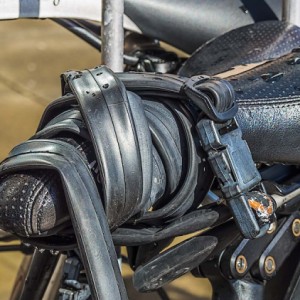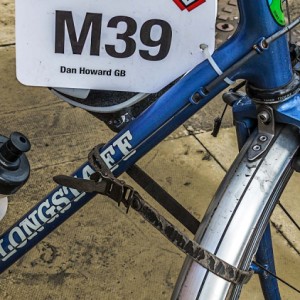LEL – Day Two.
Continuing the LEL saga, an unfortunate Spaniard had a confrontation with bollard on the cycle path through the village this evening. Although it was hissing down with rain, it was daylight, he should have seen it and his companions should have shouted a warning; however, he ended up with a broken collar bone and an undamaged bike. Someone called for an ambulance and the emergency services impressed on all concerned that “the patient should not be moved.” There was no need for the ambulance to hurry; he wasn’t an emergency, so he was expected to lie there in a puddle freezing to death. Quite reasonably he refused and a villager gave him shelter (and probably, a nice cup of tea). I was sent with a driver to collect his bike as I was the only person on duty who knew from the reports to us precisely where to find it. We arrived to find him walking around, chatting and making jokes. Once he’s been to A & E, he will be sent to London where he will meet both his bike (delivered by one of the event vehicles) and his friends who will escort him home.
When we returned to the control, there were half a dozen newly arrived riders suffering from hypothermia; the Blip is of a prime example; whether any of them continued, I don’t know. The combination of tiredness from riding 700 km, repeated heavy rain and possibly lack of fitness and inadequate clothing can take quite a toll. Food, drink and a sleep bring on miraculous recoveries for, although they are pushing themselves to their limits, they are still very fit and healthy.
During the day, we had a visit from the local cycling policeman (see first extra). No problems, just popped in for a friendly chat and to make sure all was well, though he politely declined the offer of a cup of tea and a bun. He must have the ideal job: being paid to ride a bike while wearing a uniform that guarantees him protection from the more anti-social members of the motoring community.
During the course of the day, I had been discussing with one of the other volunteers the value of worn out inner tubes; it was pure chance that I noticed this specimen (second extra) in its second incarnation. It appears to be wrapped around the saddle purely for temporary storage. If you can unravel it from the picture, you will see that it has had the section with the valve removed, and has been united with various pieces of hardware normally used with plastic webbing and available from any good DIY emporium or, alternatively, from a box containing junk “that might be useful one day.” The result is an elastic adjustable strap suitable for securing oddly-shaped items of luggage to a bicycle. I have several inner tubes that I haven’t got around to throwing away yet, and I have a junk box, I wonder what’s in it.
The final extra is of a trikie’s padlock, any trike rider will be aware of their existence. A trike does not normally need securing against theft, most felons would feel conspicuous riding off on one and would probably find that they could only ride it into kerbs, lamp-posts and parked cars. The instinct to balance a bike by steering into its lean is compulsive, which results in the trike running down any camber. I have a Blip of our retired doctor trying to ride one of mine – absolutely petrified and unable to move more than an inch at a time. However, if a trike is left unsecured, it is liable to roll down the gentlest of slopes or be carried off by a light breeze. A quick release strap provides a convenient cure for the problem.




Comments
Sign in or get an account to comment.


